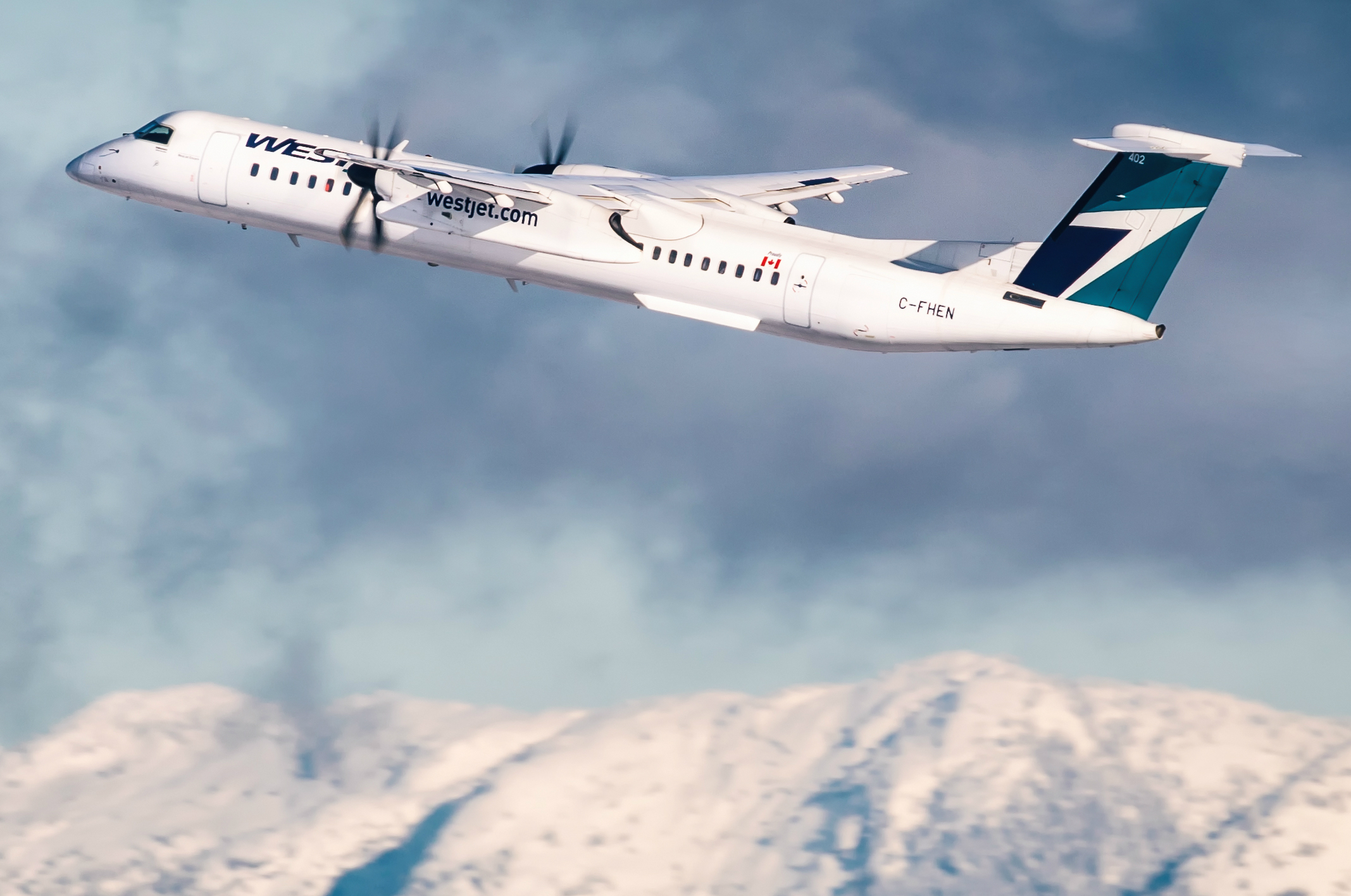Estimated reading time 21 minutes, 45 seconds.
Every day, more than 550 Bombardier Q400 turboprops fly passengers across the skies of more than 40 countries.
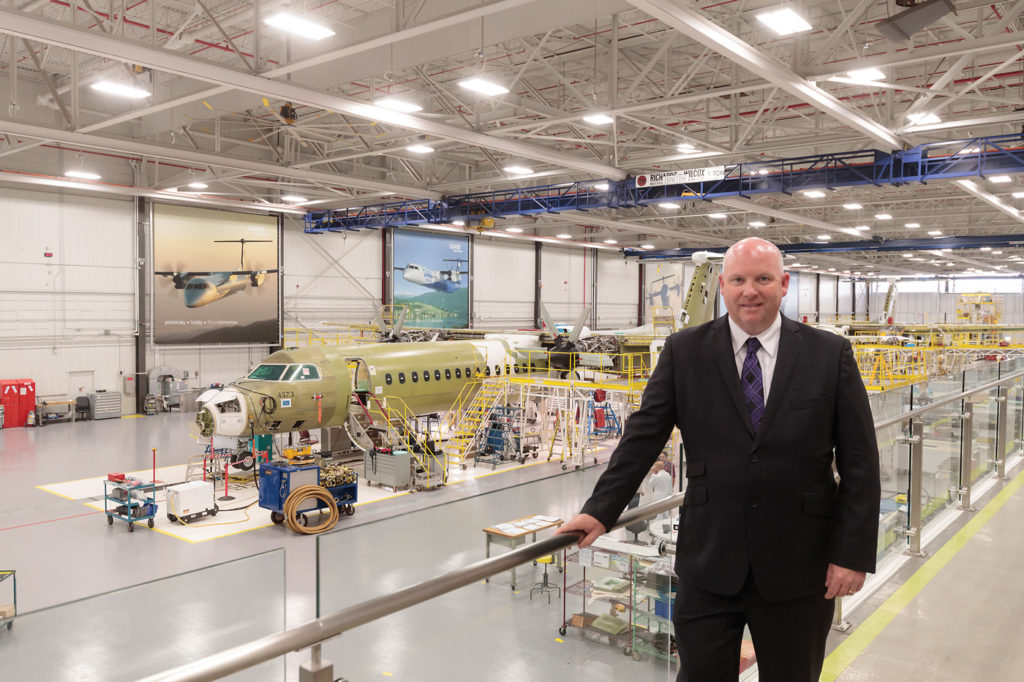
Twenty years ago, the prototype Bombardier Dash 8 Series 400 (later Bombardier Q400) flew for the first time from Runway 13-33 at Toronto’s historic Downsview Airport, on Jan. 31, 1998.
In the years since, the 360-knot (667 km/h) Bombardier Q400 has become a brand ambassador for the Canadian aerospace industry, combining a Toronto-assembled airframe with a pair of powerful 5,000-horsepower Pratt & Whitney Canada PW150A turboprops assembled in Longueuil, Que., to create the fastest and largest capacity turboprop airliner in production today.
Some in-service Q400s are flying routes long served by turboprops. Others have replaced or are complementing jet service. As well, the Q400 is widely used to connect city pairs that never had direct air service before.
The Q400’s ability to offer turboprop economics with jet performance has made it the most popular modern regional aircraft in Canada, with a strong customer base in Europe, Africa and the Asia-Pacific region, too.
Selling turboprops is more challenging for Bombardier than a decade ago, when the Q400 was part of a four-member turboprop family that also included the Dash 8 Series 100, Q200 and Q300, spanning the 37- to 76-seat market.
Production of the smaller 37- and 50-seat Dash 8s ended in 2008-2009, as airline orders declined with rising fuel prices. To be sure, there was lots of government interest in the Q200/Q300 for special mission applications (e.g. maritime patrol, search and rescue, and aerial surveillance) but Bombardier elected to reallocate the floor space in Toronto to higher value Global business jet and Q400 production.
In the decade since, France-based competitor ATR has outsold Bombardier in most turboprop markets except for North America; that is, until the late 2017 sale of 30 new ATR 72-600 freighters to FedEx and Nordic Aviation Capital’s early 2018 deal to lease at least 20 new ATRs to Florida-based Silver Airways.
Essentially, the 42-seat ATR 42-600 and 70-seat ATR 72-600 cost less to acquire and operate on short routes, whereas the high-speed Q400 has more passenger seats, better productivity and superior economics on longer jet routes, and can generate more revenue passenger miles (RPMs) per day.
Bombardier claims that the faster Q400 has the same trip cost as an ATR72 and can carry up to 14 more passengers, but more airlines have selected ATRs for shorter-haul missions.
Elsewhere, the Q400 is also being utilized in non-airline markets as a package freighter and aerial firefighting aircraft, and is in development as a missionized intelligence, surveillance and reconnaissance (ISR) platform.
New Orders
Bombardier has always maintained that regional jets and turboprops are complementary aircraft technologies that offer regional airlines the ability to match seating capacity to passenger demand, direct operating costs (DOCs) to revenue per available seat mile (RASM), and speed to stage length.
Regional airlines have accelerated their shift to larger aircraft, both turboprop and jet. Increased capacity and lower operating costs per seat of 60- to 99-seat aircraft have led to their rapid expansion as the “new” base of regional aircraft fleets.
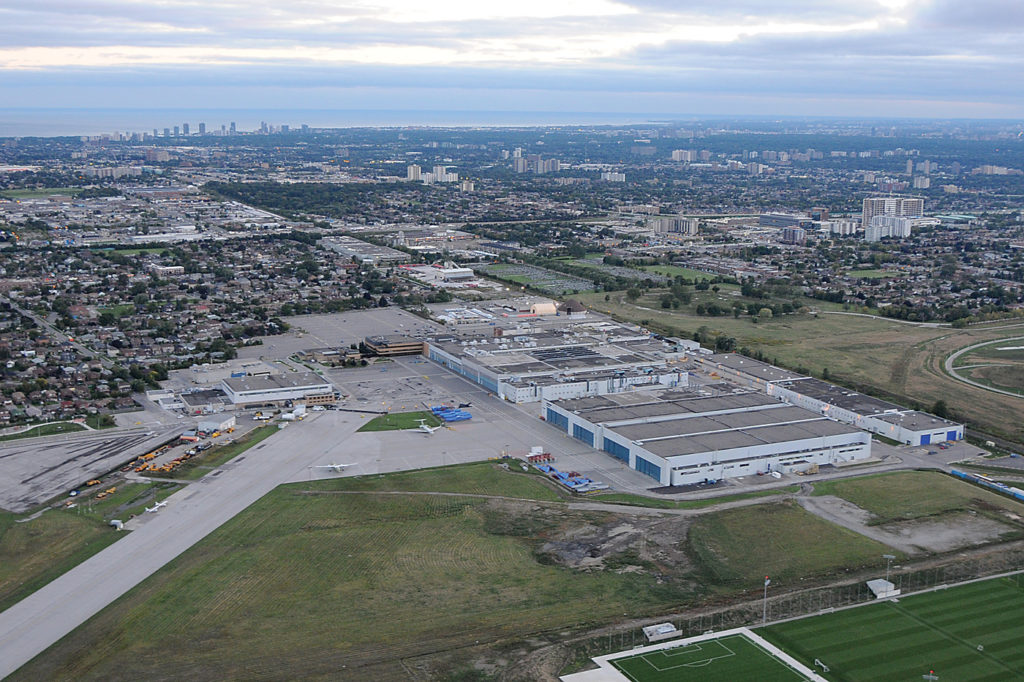
Last year, Bombardier Commercial Aircraft (BCA) delivered 30 Q400 turboprops (compared to 26 CRJ series regional jets and 17 C Series single aisle jets) and received orders for 42 new Q400s, including a record order for 25 high density, 90-seat Q400s from SpiceJet of Gurgaon, India (with 25 options), to open up new regional routes serving Tier 2 and Tier 3 cities across that country.
“We are proud to sign this agreement as it is another demonstration of the Q400’s superiority in the turboprop market … the repeat order will increase the Q400 aircraft fleet in the fast-growing market in the Asia-Pacific region, and will launch the high-density 90-passenger model of the Q400 aircraft in India,” said Fred Cromer, BCA president, at the 2017 Paris Air Show.
“This is also compelling evidence that the demand for turboprop aircraft is healthy in short- to medium-haul markets that can’t economically support jets that are more expensive to operate.”
Since 2010, SpiceJet has taken delivery of 15 Q400 aircraft and leased others. The airline currently operates 20 Q400 aircraft in a 78-seat configuration to domestic and international destinations.
Also in Paris, Philippine Airlines, Inc. announced the exercise of its seven Q400 purchase rights (boosting its Q400 fleet to 12), with the new aircraft to be the first in an 86-seat, dual class configuration. And Ethiopian Airlines revealed a previously undisclosed order for five Q400s–the airline’s fourth reorder–to boost its fleet to 24 Q400s, the largest fleet in Africa.
Bombardier executives readily admitted last September that the Q400 and CRJ had not received the required “focus and messaging” while the company struggled to win C Series sales, but the leadership is now “turning that around” and is reportedly focused on “rebuilding its (order) backlog.”
The mid-2017 announcements signalled that there is still strong customer demand for the Q400, and Bombardier’s renewed efforts to win Q400 sales are achieving results.
Dawn of the Dash 8
The Dash 8 turboprop was conceived in the late 1970s when de Havilland Canada was owned by the Canadian federal government. U.S. airline deregulation was stimulating sales of four-engine, 50-seat de Havilland Dash 7 short takeoff and landing (STOL) aircraft, but what regional airlines really wanted was a twin turboprop optimized for hub and spoke route networks.
Airline deregulation south of the border was also a catalyst for Pratt & Whitney Canada to develop the PW100 family of modular turboprop engines for commercial aircraft in the 30- to 70-seat class.
The first 37-seat Dash 8 Series 100 (DHC-8-100) entered service with norOntair in northern Ontario in 1984, and the first 50-seat Dash 8 Series 300 (DHC-8-300) with Time Air in 1989.
Boeing bought de Havilland Canada in 1986 and engineers were soon designing a high speed 70-seat Dash 8 Series 400 (DHC-8-400) to replace older technology jets in the 65- to 100-seat class. The new Series 400 was on the brink of official launch in 1990 when Boeing put de Havilland up for sale.
When a deal to sell de Havilland to arch rival ATR was blocked by the European Commission, Bombardier teamed up with the Government of Ontario (as a 49 per cent equity partner) to buy the company. Federal and provincial agencies pledged almost $600 million to revive the Toronto aircraft production operation. (Ontario sold its 49 per cent interest in 1997).
Q400 Launched
Bombardier Regional Aircraft launched the Dash 8 Series Q400 turboprop at the 1995 Paris Air Show, powered by a pair of new P&WC PW150 turboprops driving six-blade Dowty Aerospace propellers. The PW150 had almost twice the power of any other PW100 engine, giving the Dash 8-400 a cruise speed of 360 knots, significantly faster than the 285-knot Dash 8-300 (and the ATR 72).
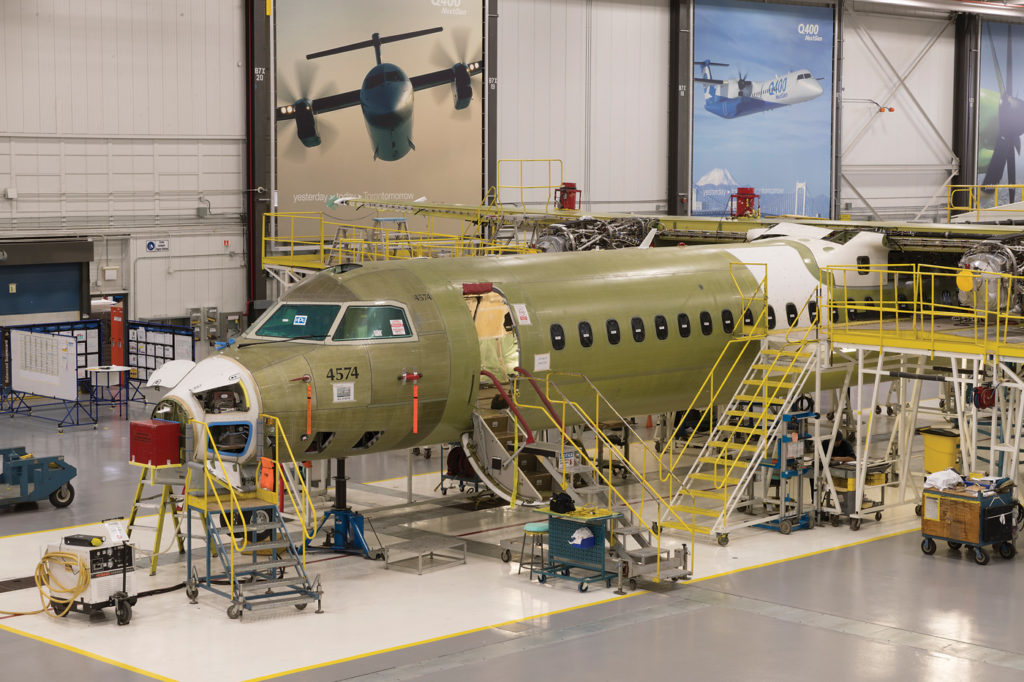
The new aircraft was also outfitted with an active noise and vibration suppression (ANVS) system to provide a cabin as quiet as a regional jet. When the entire Dash 8 family received ANVS systems, it was rebranded the Q Series (Q for quiet) and the Series 400 became the Q400.
Development of the Q400 was expected to cost $450 million, with Bombardier and its risk-sharing partners roughly splitting the cost. Eighteen months later, the company also launched the 70-seat CRJ700 regional jet to provide 50-seat CRJ100/200 customers with a larger aircraft option.
The first Q400 entered revenue passenger service with SAS Commuter in February 2000, replacing Fokker F50s. Large orders were placed by early adopters Horizon Air in the U.S. (part of the Alaska Group) and Flybe in the United Kingdom, which became the aircraft’s largest international customers.
Q400 NextGen
In 2008, the Q400 NextGen was announced as a further evolution of the aircraft’s development, with the “passenger experience” further enhanced by a brighter cabin with LED lighting, new ceiling panels and dished window sidewalls, and larger overhead bins that could accommodate more than 50 standard roller bags.
After initial teething problems, worldwide Q400 demand increased as jet fuel prices quadrupled between 2002 and 2013 from US$0.72 a gallon to US$2.98 per gallon. That’s when Q400 deliveries soared from nine aircraft in 2003 to 56 aircraft in both 2011 and 2012, before stabilizing at about 30 aircraft a year.
Market Outlook
Bombardier’s 2017-2036 commercial aircraft forecast released last September said 5,750 new large regional aircraft in the 60- to 100-seat class will be required in the next 20 years, worth US$240 billion. Turboprops and regional jets have shared this market evenly for the past decade.
This year, Bombardier is introducing a new cabin standard for the Q400 to increase the baseline seating capacity, which also provides a 20 per cent lower seat cost advantage compared to other turboprops.
The old configuration was 74 seats with a large forward baggage bay and two individual galleys at the back of the cabin. The new cabin standard has 82 seats and a large single galley at the back of the aircraft. The forward cargo compartment (located opposite the boarding stairs) has been removed and three additional windows added to provide a brighter, more spacious interior.
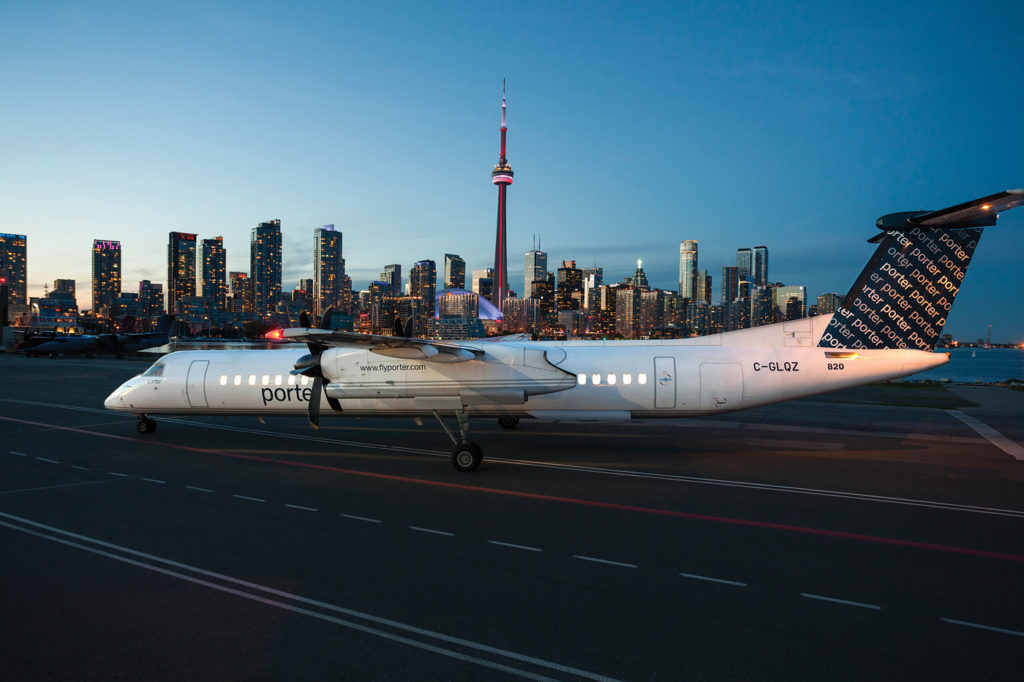
Not only does this open up the front of the aircraft, but it also provides airlines with more ways to make revenue. For example, the aircraft can be delivered with 90 seats at 28-inch seat pitch; 82 seats at 30-inch pitch; 74 seats with eight business class seats; or as a 50-seat cargo-combi with a 9,000-pound-capacity cargo compartment with 1,150 cubic feet of space (currently in service with Japan’s Ryukyu Air Commuter Co).
In addition, the forward passenger door on the Q400 is compatible with airport jet bridges to provide a seamless passenger experience. (Most ATRs have a rear passenger door.)
In the field, the Q400’s powerful PW150 engines provide a better climb rate, single-engine ceiling, and greater revenue-producing payload capability in hot weather and at high altitude airfields.
Including the Q400 NextGen upgrade, Bombardier said it has invested $300 million in upgrades over the past decade, including cabin improvements (e.g. extra seating, business class, drop down oxygen, cargo-combi, wireless IFE), avionics (e.g. ADS-B, RNP, TCAS 7.1), and operating approvals (e.g. airport operations up to 14,000 feet and narrow and sloped runway approvals).
Today, the Q400 has the longest maintenance intervals, with A-checks at 800 hours and C-checks at 8,000 hours, which provide a 20 per cent direct maintenance cost advantage and will reduce aircraft down time by up to 270 flying days (compared to competing turboprops).
By the Numbers
About 560 Q400 turboprops have been delivered from Bombardier’s Toronto factory and are flying for more than 60 different customers, including 15 added in the last five years.
The Bombardier sales team struggled to line up customers for the Q400 in the late 1990s and early 2000s, when many regional airlines were re-equipping with regional jets and executives were reluctant to bet their careers on a new turboprop.
Since the Q400 was launched, the largest new customers have included Air Berlin, All Nippon Airways, Austrian Arrows (formerly Tyrolean), Chorus Aviation (Jazz), Colgan Air/Pinnacle, Ethiopian, Eurolot, Flybe, Frontier, Horizon, JAL/Japan Air Commuter, Luxair, Porter, Qantas, SAS Commuter, Spicejet, WestJet Encore and Wideroe. Many of these airlines traded up to the Q400 from smaller Dash 8s. A large number of Q400s are now owned and traded by major leasing companies.
In 2007, Q400s were serving about 400 routes. Today, they serve about 1,200 routes, according to the Diio schedule database.
Some of the airlines flying the Q400 on routes greater than 700 nautical miles include Porter in Canada, SATA in the Azores, Ethiopian in Africa, and four European carriers: airBaltic, Austrian Arrows, Flybe and Luxair.
Already a large Dash 8 customer, Horizon, part of the Alaska Group, saw the Q400 as an ideal fit for its route network and has ordered 54 new aircraft (52 delivered) from Bombardier, which it flies on short and long (over 600 nautical mile) routes. When fuel prices increased, Horizon was lauded for its fuel efficient Q400 fleet, but last year pilot shortages forced the airline to cancel numerous Q400 flights and it is now outsourcing some flying to Skywest Embraer E175s.

Bombardier has tried hard to place Q400s with other U.S. airlines, but the merger of United and Continental, Delta and Northwest, and American and U.S. Airways left the major carriers and their regional affiliates awash with regional jets, which have squeezed out turboprops, including the United Express Q400 fleet.
Canada is now one of the largest Q400 markets with 118 in service, including Hydro Quebec (two for crew change flights); Porter Airlines (29); WestJet Encore (43); and Chorus Aviation/Jazz (44).
Porter began taking a serious interest in the Q400 almost four years before it launched its premium regional airline from Billy Bishop Toronto City Airport in the fall of 2006. Today, the airline’s 29 Q400s can easily operate from the downtown airport’s 3,988-foot paved runway to numerous destinations in Canada and the U.S.
Sky Regional introduced Air Canada Express’ first Q400s on the Montreal-Billy Bishop Toronto route and Jazz later introduced the aircraft as a 50-seat CRJ100/200 replacement. (Jazz acquired Sky Regional’s Q400s in 2017.)
WestJet Encore has used the Q400 to serve markets too small for the Boeing 737, and also supplemented 737 jet service at off-peak times of the day.
Flybe is the largest independent regional airline in Europe and the world’s largest Q400 operator. The growth of low-cost carriers (LCCs) has seen some Q400 operators fail (Eurolot and Air Berlin), but the fleets have been quickly absorbed by successor companies.
Africa is now home to more than 60 Q400s, with Ethiopian operating the largest fleet from its hub in Addis Ababa.
India is a very promising market, with government policies now supporting the developing of regional air services. Newer Asian customers like Nok Airlines in Thailand and Philippine Airlines have also introduced Q400s with high-density seating on low fare and high density routes.
Q400 on a Mission
Earlier this year, the Conair Group in Abbotsford, B.C., purchased six Q400MR aircraft from Bombardier, which it will convert into multi-role firefighting air tankers for France’s Sécurité Civile.
This is a follow-on order to the two former SAS Commuter Q400s converted by Conair (and Cascade Aerospace) into 10,000-litre (2,600 US gal) air tankers delivered in 2005-2006. The unique external retardant tank allows the quick-change cabin to be used year-round in passenger, cargo, combi transport, medevac, emergency response, surveillance and patrol without compromising the aircraft’s firefighting capabilities.
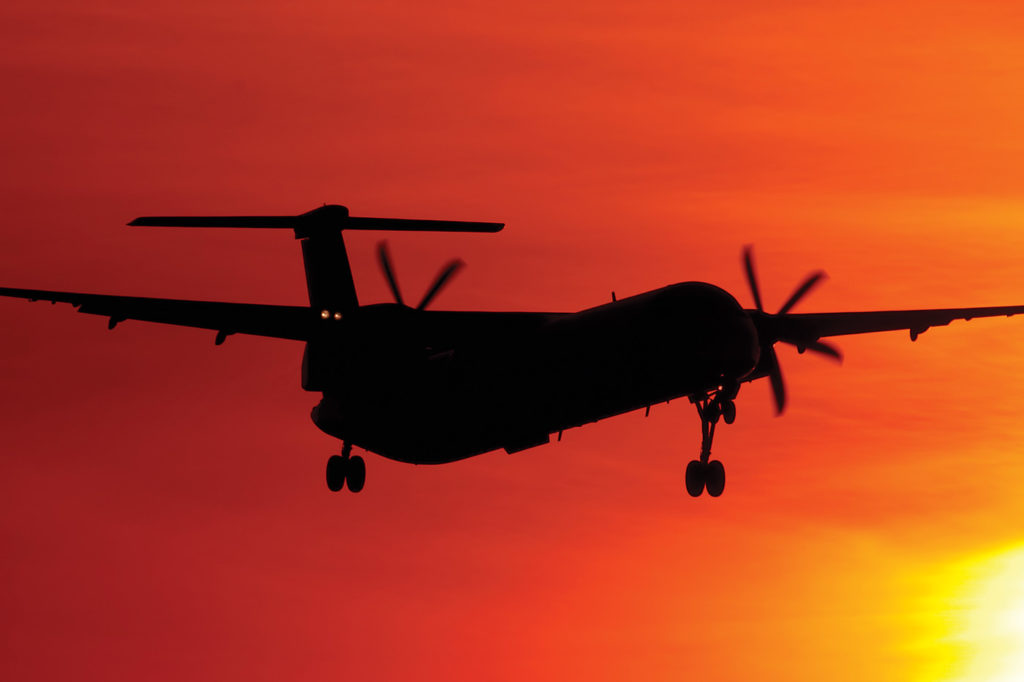
This time, Conair has contracted Flying Colours Corp. to modify the interiors of the new Q400 air tankers for France.
For its part, Cascade Aerospace (owned by IMP) has teamed with L3 to develop a Q400 Multi-Mission Aircraft featuring long-range external fuel tanks, which frees the cabin for a wide range of mission systems. The prototype flew in late 2016 and features a compartment under the belly that can accommodate a search radar, torpedos, or other mission systems.
Manufacturing Site
Step inside the cavernous Bombardier factory in Toronto, and the floor space is dominated by assembly work for the Global 5000, Global 6000 and new Global 7000 business jets. The factory sits on 1.5 square kilometres (375 acres) with an adjacent private 7,000-foot runway.
De Havilland Aircraft of Canada Limited opened its first aircraft assembly hangar in the Toronto suburb of Mount Dennis in March 1928–80 years ago–and then moved to a larger site at Downsview in 1929.
A new aircraft factory was opened off Wilson Avenue in 1954 after the wartime factory was purchased to expand RCAF Station Downsview (now part of Downsview Park). Then, in the late 1980s, Boeing expanded the plant to support Dash 8 production by adding four new production bays.
The Q400 program directly employs 800 people in Toronto in engineering, program management, manufacturing and final assembly, plus a couple hundred more in Dash 8 Q Series customer support.
The Downsview plant was once a noisy place where rivet guns pounded constantly as Dash 8 components and sub-assemblies were fabricated onsite, as well as earlier STOL aircraft. Today, business aircraft assembly dominates the site.
Bombardier has always fabricated the Q400 cockpit and wing in Toronto, but all other parts are made elsewhere and arrive as large components for final assembly with wiring or ducting already installed.
The Q400 fuselage and empennage were originally built by Mitsubishi Heavy Industries (MHI) in Japan. In 2006, production of the forward and aft fuselages and tail was reassigned to Shenyang Aircraft (SAC), a subsidiary of Aviation Industry Corporation of China (AVIC). During the transition from Japanese to Chinese suppliers, Bombardier’s Belfast factory stepped forward to provide critical components.
The Q400 fuselage is assembled in a portion of Downsview’s Bay 2 and is then transferred to the final assembly line located in Bay 5, near where Bombardier fabricates the Q400 cockpit and wing. Almost everything else incorporated into the Q400 and the Global business jet is made elsewhere.
The workstations in Bay 2 at Downsview are where the Q400’s nose and empennage are mated to the central fuselage. Since the production line was first established, the assembly process has changed to improve efficiency. It now includes ergonomically designed platforms to improve workflow and safety harnesses to reduce workplace injuries.
The assembled fuselage is then towed in a special cradle to the final assembly line in Bay 5, where wings and fuselage are mated, landing gear and engines installed, and control surfaces and cabin interior completed.
Q400 at a Crossroads?
The Q400 was launched with a lot of promise and it remains an impressive regional aircraft.
As the largest and most expensive turboprop on the market, the Q400 is an easy target when competing turboprops built by ATR (as well as in Russia and China) are smaller and sell for less.
In August 2013, Bombardier announced a preliminary agreement with Rostec and leasing firm Ilyushin Finance Co. of Russia for the sale of at least 100 Q400s, valued at $3.4-billion at list prices, that would be assembled by Rostec at a plant 900 kilometres southeast of Moscow.
This order and the opportunity to open a second production line were seen as a huge endorsement for the Q400, but the political crisis triggered when Russia annexed Crimea in 2014 killed the deal after international economic sanctions were imposed.
In 2016, unionized workers gave Bombardier their approval to transfer production of the Q400 wing to Mexico and the cockpit to China. This would reportedly save $2 million and make the Q400 price competitive with the ATR 72, according to the Toronto Star.

The cockpit and wing are still made in Toronto. While Bombardier remains committed to reducing manufacturing costs, it has yet to announce an outsourcing plan for those components.
Some analysts say the sale of the Bombardier C Series program to Airbus will reduce Bombardier’s commitment to the commercial aircraft market, especially since business aircraft sales have historically had higher margins.
Others say that with 5,750 new large regional aircraft in the 60- to 100-seat class required in the next 20 years, Bombardier is well positioned to capture a reasonable share of this US$240 billion aircraft market.
The Q400 (and the CRJ) have both suffered from a lack of investment in the last few years as the C Series program absorbed all of Bombardier’s cash.
Speaking to investment analysts during Bombardier’s Fourth Quarter and Full Year 2017 results conference call on Feb. 15, 2018, Bombardier CEO Alain Bellemare said the company’s research and development focus “was or has been on the C Series. Now that we are completing the partnership with Airbus, it gives us the ability to think about the other platforms that we have.
“We were successful last year in rebuilding the backlog on the Q. We got the largest ever order on the Q400. And now we’re spending time on the CRJ …. But for the time being, focus is on completing the C Series deal with Airbus. And then looking at how we make our other commercial aircraft stronger and better to be able to compete successfully in the marketplace.”
As fuel prices increase, the increase in direct operating costs “drives out” the crossover point between turboprop and regional jet economic efficiency, making the turboprop more efficient over longer stage lengths than it was previously.
When fuel prices increased to record highs between approximately 2003 and 2010, turboprop sales increased by 700 per cent.
However, the market entry of new regional jets equipped with the fuel efficient Pratt & Whitney PW1000 geared turbofan that burns 20 per cent less fuel–such as the Embraer E175-E2 and Mitsubishi MRJ–will further close the gap between turboprop and regional jet direct operating costs.
That’s one of the reasons why Pratt & Whitney Canada has been developing a Next-Generation Regional Turboprop (NGRT) engine with 5,000 to 7,000 horsepower and significantly lower fuel burn for new 90-seat-class turboprops.
Just where Bombardier might find the funds required to develop a new generation Q400 (and CRJ) was unclear until mid-January 2018, when news broke that the company was actively soliciting bids for its entire Downsview factory and airport site from at least a dozen major land developers.
The value of the site has been reported to be in the neighbourhood of $500 million-plus.

Thirty years ago, Bombardier announced plans to redevelop Canadair’s Cartierville Airport site a few years after it bought Canadair from the Canadian government. In that case, Bombardier maintained a large fabrication plant at Cartierville, but moved the final assembly line for the Canadair Challenger and CL-215 waterbomber to Dorval Airport, where a new production line for the CRJ was also established.
Proceeds from the sale of Cartierville were used to finance new Bombardier aircraft programs.
It’s an open question as to whether Bombardier would use the proceeds of the sale of the de Havilland factory site (originally acquired in 1992 with the Ontario government as a 49 per cent partner) and the runways at Downsview (acquired from the federal government) to pay down debt, retain a share of the C Series program, or finance the development of new aircraft programs, such as a successor to the Q400.
But selling the Downsview site may not be an easy solution for Bombardier.
In mid-March, the Toronto Star reported that Unifor, the union representing about 2,000 Bombardier Downsview staff, is petitioning government to deny the rezoning of the site for residential development. Currently, the land is reserved for industrial use, but rezoning it for residential purposes would open the gates to more potential buyers.
Scott McIlmoyle, president of Unifor Local 112, told the newspaper that the union doesn’t want to move the facility.
“Our position is that we’re going to do everything we can to keep our members and our work right there.”
One longtime Toronto aerospace executive believes the land should not be sold.
“The governments of Ontario and Canada helped Bombardier acquire the Downsview site to expand the aircraft manufacturing industry in the City of Toronto,” said the executive. “They didn’t give them taxpayer land and money so Bombardier could enrich itself by selling the land and closing the factory.”
While it evaluates options for the sale of the Downsview lands, Bombardier is reportedly considering other scenarios, including relocating production to Toronto Pearson International Airport.
During a February conference call, Alain Bellemare, Bombardier president and CEO, said the company has been considering the future of the Downsview property for quite a while.
In mid-March, Bloomberg reported that Bombardier had hired Toronto-Dominion Bank to find a buyer for the land. Multiple bids have apparently been received, including from residential developers.
Calling the property an “underutilized asset,” Bellemare said he hoped a deal could be closed “relatively quickly in 2018.”
